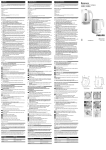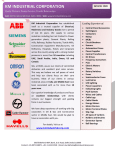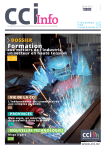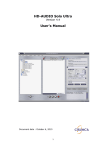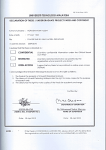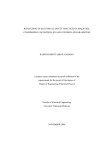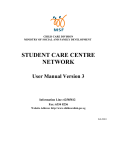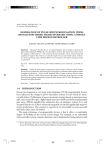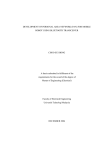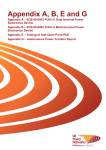Download UNIVERSITI TEKNOLOGI MALAYSIA
Transcript
PSZ 19:16 (Pind. 1/07) UNIVERSITI TEKNOLOGI MALAYSIA DECLARATION OF THESIS / UNDERGRADUATE PROJECT PAPER AND COPYRIGHT SYAIFUL ARIFF BIN AMAR @ OMAR Author’s full name : 01/03/1987 Date of birth : Title : EARTH FAULT INDICATION IN MEDIUM VOLTAGE 2009/2010 II Academic Session: I declare that this thesis is classified as : CONFIDENTIAL (Contains confidential information under the Official Secret Act 1972)* RESTRICTED (Contains restricted information as specified by the organisation where research was done)* OPEN ACCESS I agree that my thesis to be published as online open access (full text) I acknowledged that Universiti Teknologi Malaysia reserves the right as follows : 1. The thesis is the property of Universiti Teknologi Malaysia. 2. The Library of Universiti Teknologi Malaysia has the right to make copies for the purpose of research only. 3. The Library has the right to make copies of the thesis for academic exchange. Certified by : SIGNATURE 870301-23-5241 (NEW IC NO. /PASSPORT NO.) Date : 30 NOTES : * APRIL 2010 SIGNATURE OF SUPERVISOR PROF. IR. DR. ABDULLAH ASUHAIMI BIN MOHD ZIN NAME OF SUPERVISOR Date : 30 APRIL 2010 If the thesis is CONFIDENTIAL or RESTRICTED, please attach with the letter from the organisation with period and reasons for confidentiality or restriction. DECLARATION “I hereby declare that I have read this thesis and in my opinion this thesis is sufficient in terms of scope and quality for the award of the degree of Bachelor of Electrical Engineering ” Signature : ………………………. Name of Supervisor : Prof. Ir. Dr. Abdullah Asuhaimi Bin Mohd Zin Date : 30 April 2010 EARTH FAULT INDICATION IN MEDIUM VOLTAGE SYAIFUL ARIFF BIN AMAR @ OMAR This thesis is submitted in partial fulfilment of the requirements for the award of the degree of Bachelor of Electrical Engineering Faculty of Electrical Engineering Universiti Teknologi Malaysia APRIL 2010 ii I declare that this is thesis entitled ‘Earth Fault Indication In Medium Voltage’ is the result of my on resource expect as cited in the references. The thesis is has not been accepted for any degree and is not concurrently submitted in candidature of any other degree. Signature : .................................... Name : Syaiful Ariff Bin Amar @ Omar Date : 30 April 2010 iii Dedicated, in thankful appreciation for support, encouragement, and understandings To: My Supervisor, Prof. Ir. Dr. Abdullah Asuhaimi Bin Mohd Zin My beloved mother, Habibah bte Hj. Veeran and to all family members; Also all my beloved friend SEE student batch 2007-2010, And all person contribute to this project iv ACKNOWLEDGEMENT In the name of Allah, the Most Beneficent and the Most Merciful. It is deepest sense gratitude of the Almighty that gives me strength and ability to complete this final project report. First of all, I would like to thank my supervisor, Prof. Ir. Dr. Abdullah Asuhaimi Bin Mohd Zin for his valuable guidance, kindness, support and concern throughout the two semesters until finishing the report. His valuable help and suggestion is very important for me to complete my project. In this part, I would like to express my thanks to TNB Batu Pahat especially to En. Mashirwan bin Shafi’i (Maintenance Engineer) which allows me to use the equipment and all the information which I need to accomplished my projects. My outmost thanks to all my friends who also give some help and support for my project. Words cannot adequately express my deepest appreciation goes to my family, for their encouragement, love, support and infinite patience. Without them all whose support, guidance, understanding and encouragement, this thesis could ever have been written. . v ABSTRACT Protection is an important aspect in power system. Protection system must able to work fast and automatically disconnect the part where a fault had occurred in the power system. Fault indication is very important to TNB in order to give a convenience service to all customers. Every substation was installed with an Earth Fault Indicator (EFI) which usually equipped with light indicator such as light emitting diode (LED). An LED indicator is not enough due to the fact that it only help TNB to find where the substation is located. The important question is not where but when will be an earth fault occurred? The aim of this project is to solve that problem by developing a system that will enhance the indication system of the EFI. The EFI was improved by connecting the sensor part of the EFI to a buzzer and a Global System for Mobile communications (GSM) modem. When a breakdown occurred due to an earth fault, the buzzer will activate and the GSM modem will operate and send the information through mobile phone. This method will not only will help utility to have an early notice when a fault occurred but, customers also does not have to wait long time for the restoration of supply. vi ABSTRAK Perlindungan adalah suatu aspek penting dalam sistem tenaga elektrik. Perlindungan harus mampu bekerja dengan cepat dan secara automatik untuk memisahkan bahagian yang rosak daripada sistem. Penunjuk kerosakan sangat penting untuk Tenaga Nasional Berhad (TNB) dalam rangka memberikan perkhidmatan kemudahan kepada seluruh pelanggan. Setiap pencawang perlu dipasang dengan Penunjuk Kerosakan Bumi (EFI) yang biasanya dilengkapi dengan lampu penunjuk seperti LED. Penunjuk LED tidak cukup kerana ia hanya membantu TNB untuk mencari kerosakan itu berada. Soalan yang penting ialah bukan di mana tetapi bilakah kerosakan bumi akan berlaku? Tujuan projek ini adalah untuk mengatasi masalah tersebut dengan menghasilkan sebuah sistem yang akan meningkatkan sistem penunjuk EFI. Sistem penunjuk EFI akan dipertingkatkan dengan menyambungkan bahagian sensor dari EFI ke loceng dan modem GSM. Ketika pengahtaran kuasa terhenti kerana adanya kesalahan bumi, loceng akan berbunyi dan mengaktifkan modem GSM. Modem GSM akan beroperasi dan menghantar maklumat melalui telefon selular. Kaedah ini bukan hanya akan membantu utiliti mengetahui kerosakan ke bumi lebih awal bahkan, pelanggan juga tidak perlu menunggu lama untuk pemulihan sumber bekalan kuasa. vii TABLE OF CONTENTS CHAPTER 1.0 TITLE PAGE DECLARATION ii DEDICATION iii ACKNOWLEDGEMENT iv ABSTRACT v ABSTRAK vi TABLE OF CONTENTS vii LIST OF FIGURES x LIST OF ABBREVIATIONS AND SYMBOLS xii LIST OF APPENDICES xiii INTRODUCTION 1.1 Background Research 1 1.2 Problem Statement 4 1.3 Objectives of the Project 5 1.4 Scope 5 1.5 Methodology 7 1.6 Thesis Outline 8 viii 2.0 LITERATURE REVIEW 2.1 2.2 2.3 2.4 2.5 3.0 Earthing System 10 2.1.1 Isolated neutral systems 12 Types of Faults on a Three Phase System 15 2.2.1 Earth Faults 16 Earth Fault Indicator (EFI) 17 2.3.1 Earth Fault element 18 Global System for Mobile (GSM) 20 2.4.1 GSM Technology 21 2.4.2 SMS Protocols 22 Summary 22 METHODOLOGY 3.1 3.2 3.3 3.4 The Simulation of an Earth Fault Phenomenon 23 3.1.1 Introduction to Matlab and Simulink 24 3.1.2 Earth Fault Model 25 The EFI operation and the advantages 26 3.2.1 27 EFI’s operation flow chart 3.2.2.1 The advantages of EFI 28 GSM modem (software and hardware) 29 3.3.1 The operation of the improved EFI 29 3.3.2 PIC controller board 30 3.3.3 MikroC 33 3.3.4 Visual Basic 34 3.3.5 Hardware Construction 35 3.3.5.1 Preparing the PCB 35 3.3.5.2 The Etching 38 3.3.5.3 The Drilling 39 3.3.5.4 Soldering the Component 40 Summary 41 ix 4.0 TESTING, RESULT AND DISCUSSIONS 4.1 The Result from Simulation of the Earth 42 Fault Phenomenon by Using Matlab and Simulink Software 5.0 4.2 The Improvement of the EFI Indication System 45 4.3 Discussions 47 4.4 Summary 48 CONCLUSION & RECOMMANDATIONS 5.1 Conclusion 49 5.2 Recommendations 50 6.0 REFERRANCES 52 7.0 APPENDICES 55 x LIST OF FIGURES FIGURE NO. TITLE PAGE 1.1 The location of EFI in a substation 3 1.2 Study scope single line diagram 6 1.3 Methodology flow chart 7 2.1 Earth fault in a network with an unearthed neutral 12 2.2 Pre-fault voltages UA, UB, UC, neutral point 14 displacement voltage U0 and voltage of healthy phases U’B, U’C during a phase-to-earth fault in an isolated system 2.3 Types of faults on three phase system 15 2.4 Earth Fault Indicator 18 2.5 Current transformer 19 2.6 Key elements in GSM network structure 21 3.1 Earth fault model by Matlab and Simulink 25 3.2 Control box parameter of a fault breaker 26 3.3 The operation of EFI 27 3.4 EFI’s flow chart 27 3.5 EFI advantages diagram 28 3.6 The operation of the improved EFI 29 3.7 PIC16F84A microcontroller 31 3.8 The pin diagram of the PIC16F84A 31 3.9 The GSM modem circuit 32 xi 3.10 Interfacing of Mikroelektronika mikcoC 34 3.11 Printed blue matt 37 3.12 Clean black print onto the copper 37 3.13 The etching process 38 3.14 A cleaned PCB board 39 3.15 The board after soldering process 41 4.1 Voltage, line current and fault current for CB1 and CB2 43 for single phase to earth fault 4.2 Voltage, line current and fault current for CB1 and CB2 44 for two phases to earth fault 4.3 Voltage, line current and fault current for CB1 and CB2 44 for three phases to earth fault 4.4 Normal condition of an EFI 45 4.5 EFI indicates an earth fault has occurred 46 4.6 New EFI which equipped with a buzzer and a GSM 46 modem in normal mode 4.7 Shows the new EFI when an earth fault occur 47 xii LIST OF ABBREVIATIONS AND SYMBOLS TNB Tenaga Nasional Berhad EFI Earth Fault Indicator IEC The International Electrotechnical Commission LED Light Emitting Diode GSM Global System for Mobile IEEE Institute of Electrical and Electronics Engineers. PIC Programmable Interface Controller CT Current Transformer A.C Alternating Current. DC Direct Current MS Mobile Station BTS Base Transceiver Station BSC Base Station Controller SIM Subscriber Identity Module SMS Short Message Service PCB Printed Circuit Board kV Kilo Volt R Resistance C Capacitance Angular Velocity kΩ Kilo Ohm E Electromotive Force xiii LIST OF APPENDICES APPENDIX TITLE PAGE A EFI User Manual 56 B PIC 16F84A Data Sheet 61 CHAPTER 1 INTTRODUCTION 1.1 Background Research. According to The International Electrotechnical Commission (IEC) which is the global organization that prepares and publishes internasional standards for electrical and electronic product (IEC 60038), medium voltage is voltage level at 5kV, 11kV, 22 kV, 33kV and 66kV. The distribution network in Malaysia is mostly 11kV and 22kV (at certain area). There many types of protection system in the distribution network due to more and more concern in delivering a high efficiency of power supply. Distribution networks are becoming more like transmission networks where generation and load nodes are mixed, and a more complex protection system design is unavoidable. 2 The power system that we have today is connected to heavy load as the numbers of user of electricity is increasing rapidly. This happens because of the rise of the industrial section which is the major electricity consumption. If the power system is not properly handled, it will cause a great loss to the industry and livings. Thus, it is important for researches and development section to focus more attention to protections system of our power system. Any fault in distribution system circuit must be solved quickly otherwise it may result in disconnections of supply to the customers. It is important to reconnect the supply as soon as possible, but it is difficult to know where and when the fault had occurred and it may take long time. Protection is an important aspect in power system. It deals with the protection of electrical power systems from faults through the isolation of faulted parts from the network. The protection scheme objective is to keep the power system stable by differentiate or isolate only the components that are under fault, while keep the other part of network continue operating . For that, protection schemes must apply an effective way of approach to clear the system from faults. It also must be fulfilling several basic needs which include [2]: 1. Able to work fast and automatically disconnect the part where a fault had occurred in the power system. 2. Able to minimize disruption at power supply to areas not affected by fault and to ensure the maximum electricity supply to consumer. Delay in clearing fault can cause unnecessary damages to appliances and power plant hazardous to livings. 3 One of the faults that might occur is an earth fault. In electricity supply systems, an earthing system defines the electrical potential of the conductors relative to that of the earth's conductive surface. The choice of earthing system has implications for the safety and electromagnetic compatibility of the power supply. It is estimated about 80 % of all electrical faults in networks with rated voltage above 1 kV are single-pole earth faults. Hence this topic is regarded as particularly important for utilities. Since the kind of neutral grounding strongly determines the effects of a potential ground fault the system neutral grounding approach deserves serious consideration [3]. Possible effects caused by an earth fault are: 1. hazards for human safety 2. thermal stress due to fault current 3. voltage stress (transient and sustained) 4. interference with telecommunication lines 5. Interruption of power supply. An Earth Fault Indicator (EFI) is important equipment in a substation. It helps Tenaga Nasional Berahd (TNB) workers to save time in searching where the fault had occurred. Thus, reducing the sectionalising time and increase the restoration time of supply. Figure 1.1 showed the location of EFI in a substation. Figure 1.1: The location of EFI in a substation 4 1.2 Problem Statement. Studies about earth fault is getting more attentions each day, this is due to the fact that earth faults are not only by far the most frequent faults of all. However, the magnitude may be limited by neutral earthling impedance and earth contact resistance. Earth faults can be detected by using a relay which only responds to residual current of a system; residual component only exist when faults current flows to earth. Earth faults are mainly encountered in overhead medium voltages, where lives conductor contact is possible with earthed objects (ground, trees, buildings, poles and others). From my studies during the industrial training, customers in certain rural part of area in Parit Raja, Batu Pahat, Johor have to call TNB to inform them about a breakdown had occurred. Unfortunately, it is very inconvenience for TNB to get the information from the customer. The longer time it took for the customer to call TNB, the longer it took for TNB to overcome the fault and restore the supply. It is important to have a system that overcomes the problem from the situation above. One of the solution is through connected the relay through a GSM modem. A GSM modem will send the information through a mobile phone. 5 1.3 Objectives of the Project. The objectives for this study can be described as follows: 1. To study how an earth fault indicator operate and the advantages. 2. To do a simulation of an earth fault phenomenon. 3. To improve the EFI by indicating sound (buzzer) and through a mobile phone. 1.4 Scope. In the process to developing the program for the earth fault, the scope of study that I have chosen for this researches as follows: 1. Conduct studies of earth fault protection operation by referring to past projects done similarly to this project as reference. 2. Conduct study on the earth fault indicator widely used by Tenaga Nasional Berhad (TNB) which is Endau EXT03 and Cable Troll 2500. 3. Conduct study on the operation of earth fault indicator and the phenomenon of the earth fault at TNB Batu Pahat. 4. Design the GSM modem system and testing on the system. 6 The scope of my study only covers three types of faults which is the phase to earth faults (single line to ground), phase to phase to earth faults (double line to ground) and three phase to earth faults (triple line to ground). Phase to earth faults (L-G). These are predominant in terms of frequency of occurrences. In practices positive sequences are required to determine the magnitude of the individual zero sequences current flowing in each phase of the faulted circuit. The double line to ground (2L-g) statistically showed that they are less frequent than single line to ground faults. Double line to ground faults can cause zero-sequences higher than singe line to ground. Three phases to earth faults is less frequent then single and double line to ground. As a study case, a typical part of the Pt. Raja 11kV urban network has been selected, consisting of pole mounted substation and indoor substation s shown in figure 1.2. Simulation results are presented and discussed for a variety of faults on the network. Figure 1.2: Study scope single line diagram 7 1.5 Methodology. Start Study on the related problem: earth fault, hardware and software. Define the objectives of the project. Learn and study related software: Matlab, visual basic and microcontroller. Set up the system configuration. Write the source code and compile the source code to test it. No Achieve the desired output Yes Implement the circuit to circuit board. End Figure 1.3: Methodology flow chart 8 This project is divided into several parts to make sure the work is going smoothly and according to plan. Figure 1.3 showed the flow chart of my project. The first step is to be to study the nature of earth fault phenomenon. This step was completed by doing literature review. The material or reference for my study are from IEEE, several open access journal and pass year projects. There are a few software which been used in this project such as Matlab, Visual Basic and Micro-Controller. Matlab software is used order create the earth fault phenomenon. From this simulation, the characteristic of the earth fault can be determined. The Visual Basic software with ActiveXperts GSM Modem Toolkit and microcontroller had been used in order to design the software for the GSM modem. PIC microcontroller model PIC16F873A was used and studied especially the connection for the input and output, writing and assembly the program, and the other circuit need to support the microcontroller circuit. 1.6 Thesis Outline. This thesis is divided into 5 different chapters based on what was done to accomplish this project. The first chapter, will gives a brief of introduction of the phenomenon of an earth fault and the uses of EFI in TNB. It also discussed the problem statement, project objectives, scopes of the project and the methodology’s flow charts. The second chapter will focus on the literature review. This literature reviews are based and discussed on the earthing systems in the isolated neutral systems and the types of faults on a three phase system which will be focused on the earth fault. Besides that, this chapter will also discuss the EFI and the Global System for Mobile (GSM). 9 The third chapter provides the project methodology. This chapter is divided into three parts for three objectives restively. This chapter explains what I have done and the step taken in order to accomplish the objectives of this project. The three parts are the simulation of the earth fault phenomenon, the EFI operation and its advantages and lastly, the preparation of the GSM modem. Meanwhile, the fourth chapter is the testing and result. This chapter explains the procedure and result of this project. This chapter also contains the simulation result of the earth fault phenomena and the hardware results of the improved EFI. Lastly, the fifth chapter will be the conclusion and recommendation. It provides explanations of this project based on the result gathered. Besides that, it also provides the future recommendation regarding to this project. CHAPTER 2 LITERATURE REVIEW 2.1 Earthing System. In electrical power system, an earthing system can be described as an electrical potential between the conductors to the earth’s conductive surface. In order to choose the earthing system, it is important to remember that different type of protection has different effects on the safety and electromagnetic compatibility of the power supply. Different from protective earth connection, a functional earth connection will not provide protection against electrical shock but it may carry a current during normal operation. Other devices such as surge suppression electromagnetic interference filter, antenna and other type of equipment and various measurement instrument [1]. 11 The objective of earth connection is to ensure that all exposed conductive surfaces are at the same electrical potential as the surface of the earth. This is to avoid the risk of electrical shock if a person touches a device in which an insulation fault has occurred. Furthermore, it ensures that overcurrent protection devices (fuse, circuit breaker) triggered during short circuit (electrical shock) in order to disconnect the power supply. A functional earth connection may carry a current during the normal operation which required by some devices such as surge suppression and electromagnetic interference filters, some types of antennas and various measurement instruments [2]. Earthing system are differentiate into three categories of earthing arrangement using two letter codes TN, TT and IT. The first letter (T and I) indicates the connection between earth and the power-supply equipment (generator or transformer). While the second letter (T and N) shows the connection between earth and the electrical device being used [15]. T: direct connection of a point with earth. I: no point is connected with earth / isolated T: direct connection of a point with earth. N: direct connection to neutral at the origin of installation, which is connected to earth. The earthing design is considered the single most important parameter to determine the earth fault behaviour in a power system. A power system can have more than one neutral point but they do not have to be connected to earth, using the same earthing method [3]. Two important functions of neutral earthing are to detect earth faults and to control the fault current, since large fault currents can cause the potential rise of exposed parts of the power system to reach dangerous levels. A few type of earthing system such as solidly earthing as well as the three most common types of nonsolidly neutral earthing; isolated neutral (discussed), resistance earthing and resonant earthing [1]. 12 2.1.1 Isolated Neutral Systems. Usually the neutral point of an electrical system is connected to earth ground, since ground and earth are closely related. If a current flows through on a grounding conductor can be very dangerous due to the high voltage arises on the equipment. Thus, it safe to take a precautions step by installing grounding conductor and neutral conductors which is clearly stated in the electrical regulations. Current flowing to earth has only two paths—it can flow to earth through an earth fault, and it can flow to earth through distributed capacitance. Current flowing to earth through distributed capacitance can cause sympathetic tripping during an earth fault and it can cause nuisance tripping during normal operation [8]. Isolated neutral system is when a system with all transformer neutrals is unearthed. The only intentional connection between an unearthed neutral and earth is by high impedance equipment for protection or measurement purposes such as surge arresters or voltage transformers. In a power system there are however always capacitive connections between the phases and earth. The strength of the capacitive connection depends on type and length of the power system circuit. When an earth faults occur in the system, the capacitance to earth of the faulty phase is bypassed. Figure 3 shows an earth fault in a system with one unearthed neutral [6]. Figure 2.1: Earth fault in a network with an unearthed neutral 13 The maximum earth fault current of an isolated system is small providing the system’s capacitive connection to earth is weak. The presence of a fault resistance means a resistive part is added to the systems equivalent impedance as shown in figure 2.1. The reduced fault current will therefore consist of a resistive and a capacitive part as shown in equation 2.1. The earth fault current in case of a non-solid earth fault as in equations 2.2 and 2.3 [5]: ........………………………….…………….…..………...…(2.1) ..….….…………………......................................................(2.2) ……………………………………………...…….……..….(2.3) The fault current gives rise to a zero sequence voltage across the capacitances. A zero sequence is also known as flux summation and involves putting a window-type current transformer (CT) around all three phase conductors. Normally, the flux of the three phase conductors should sum to zero so there will be no current in the CT secondary. If there is a ground fault, phase currents are not balanced, flux is not zero and there is secondary current in the CT proportional to the primary ground current [7]. Unbalance in the phase-to-earth capacitances (Xc≠Xb≠Xa) will result in a steady state zero-sequence current [16]. The main advantage of unearthed neutral in power systems is small earth fault currents which do not require immediate shut down, but the main problem is the over-voltage that resulted by charging of the system capacitance of the sound phases, which may lead to flashover or breakdown [9]. 14 Figure 2.2 shows the pre-fault phase voltages, the neutral point displacement voltage and the voltage of the healthy phases during a phase-to-earth fault in an isolated system. The voltage between the neutral point and the healthy phases will remain unchanged during the fault. A neutral point displacement voltage therefore remands a change in the healthy phase to earth voltage level. The maximum voltage of the healthy phases is 105 % of the pre-fault phase-to-phase voltage. This is consists with [4], the earth fault relay is therefore completely unaffected by load current and it can be given a setting which is limited by the design of the equipment. In isolated neutral systems some phase-to-earth faults are cleared without involving any relay operation. Figure 2.2: Pre-fault voltages UA, UB, UC, neutral point displacement voltage U0 and voltage of healthy phases U’B, U’C during a phase-to-earth fault in an isolated system. 15 2.2 Types of Faults on a Three Phase System. There are a few type of fault which can occur in the power system. Figure 2.3 below shows the types of faults that can occur on a three phase A.C. system [10]. According to the figure there are eight possibly types of faults which can occurs in the three phase power system. All these type of fault is very dangerous and can cause immediate death. Figure 2.3: Types of faults on three phase system The types of faults on a three phase system: 1. Phase-to-earth fault 2. Phase-to-phase fault 3. Phase-to-phase-to-earth fault 4. Three phase fault 5. Three phase-to-earth fault 6. Phase-to-pilot fault * 7. Pilot-to-earth fault * * In underground mining applications only 16 On the other hand, the magnitude of earth faults currents will be determined by the manner in which the system neutral is earthed. Solid neutral earthing means high earth fault currents as this is only limited by the inherent earth fault (zero sequence) impedance of the system. It is possible to control the level of earth fault current that can flow by the choice of earthing arrangements for the neutral. In other words, by the use of Resistance or Impedance in the neutral of the system, earth fault currents can be engineered to be at whatever level is desired and are therefore controllable. This cannot be achieved for phase faults. 2.2.1 Earth Faults. Earth fault means the fault that occurs when the current carrying conductor or live part get connected or touched with earth as showed in figure 5. A lot of things can cause an earth faults, such as [16]: 1. Insulation failure 2. Cable damaged by any excavation works 3. Overloads 4. Due to dust 5. Any animals are enter into the panel 6. Any loose objects near the power system 17 Earth faults are mainly encountered in overhead medium voltages, where lives conductor contact is possible with earthed objects (ground, trees, buildings, poles and others) [11]. The associated fault resistance may vary from a few Ω up to several tens of kΩ. In general, the earth faults refer to fault currents less than 100 A. The high impedance earth faults usually occur at overhead and pole-mounted distribution substations which are often connected to underground cable feeders. In networks with directly earthed zero-point an earth fault is equivalent to a phase to earth short circuit. In that case the current magnitude will be somewhat lesser than in the case of a phase to phase short circuit. For networks that do not have directly earthed zero-point, the magnitude of the singular earth fault current is ruled by the size of the galvaniycally interconnected network, voltage level, type of cable and the zeropoint equipment. 2.3 Earth Fault Indicator (EFI). An EFI shown in figure 2.4 is a product for indication of earth faults in 6 to 36 kV or medium voltage network. The CT measures the imbalance in the feeder during an earth fault. All indicators located between the feeding transformer and the fault location will indicate. The EFI consists of a sensing part and indicator part [12]. In networks with directly earthed zero-point an earth fault is equivalent to a phase to earth short circuit. In that case, the current magnitude will be lesser than in the case of phase to phase short circuit. When a faults occurred the total current in the system is increased dramatically which caused by the short circuit of the system. Thus, increases the voltage. The CT will detect and compared to a user set reference value, the trip level. The trip level is adjustable in the range from 5 to 120 A (40A normally in Malaysia). If the ct current 18 exceeds the trip level, the indicator is activated. The mean rectified value of the earth fault signal is used as a basis for activation. This way, the local indication for transient faults and stationary faults are treated equally. Figure 2.4: Earth Fault Indicator 2.3.1 Earth Fault Element. The earth fault element is a summing CT shown in figure 2.5, which generates a current when the vectorial sum of the three phases becomes different from zero (during earth fault). When there is no earth fault, the vectorial sum is approximately to zero [13]. While in the sensing part the CT current is compared to a user set reference value, the trip level. When the CT current exceeds the trip level, the indicator activated. The mean rectified value of the earth fault signal is used as a basis for activation. This way local indication for transient faults and stationary faults are treated equally. 19 Figure 2.5: Current transformer U= ∑I= Ir+Iy+Ib=0 (Normal ideal load) There are several which can cause an output of CT such as [16]: 1. Unbalance in the phase-to-earth capacitances (Xc≠Xb≠Xa) 2. Phase-voltage unbalance ( Van≠Vbn≠Vcn) 3. DC-offset component from motor starting; switching 4. Local saturation in a core-balance of CT. 5. The presence of harmonic-frequency voltages (integer multiples of the fundamental frequency) in an electrical system. 20 2.4 Global System for Mobile (GSM). Global System for Mobile or is well known as GSM is originally called Groupe Spécial Mobile is digital telephone mobile system that is widely used in all over the world including Malaysia. Mobile phones used a service carrier’s GSM network by searching for cell phone towers in the nearby area. It is estimated that 80% of the global market uses the standard according to the GSM Association. It ubiquity allowing international roaming arrangements between mobile phones and operator scan be done anywhere all over the world. GSM system is quite difference from the older versions, GSM uses digital technology for both signalling and speech channel. The existence of the GSM system gives a lot of benefits to both customers and network operators. In addition, GSM also one of the pioneer in the implementation of the low cost short message service (SMS) or text messaging which has been supported by most mobile phone today all around the world. Other benefits from this system that it includes with worldwide emergency telephone number which is very important for travellers. 21 2.4.1 GSM Technology. A normal GSM Network contains three important part which is the Mobile Station (MS) or similar to wireless phone with extra feature, the Base Transceiver Station (BTS) which controls link to the Mobile Station and the Base Station Controller (BSC) which take care the multiple Base Transceiver Station. The two basic things to make up the Mobile Station is a Subscriber Identity Module (SIM) card of any operator network and a digital mobile phone. The SIM card contains all the important details about the user identification [14]. A numeric string is the first three digits represent the origin of the SIM (operator in that specific country). While the other digits represent the subscriber’s identity in his home network, phone memories, billing information, short message service (SMS) text messages, pin numbers and international roaming information. The figure 2.6 shows the key elements in GSM networks. Figure 2.6: Key elements in GSM network structure 22 2.4.2 SMS Protocols. There were 3 ways to implement SMS control, the original Block Mode, AT Commands-based Text Mode, and AT commands-based PDU Mode. These fought it out in the market place, and although the SMS Block Mode was included in Nokia’s Cellular Data Card for the 2110 in 1994, the Block Mode has now faded away and been replaced by PDU Mode. 2.5 Summary. In this chapter, an introduction regarding on the literature review was discussed. The objective of the earth connection was and the characteristic of the earth fault was well explained. This chapter also provides the information about the example of what can cause the earth fault and a brief of information about the EFI was told. In addition, the information about GSM, which part of the system was determined. The next chapter will discuss the methodology. Methodology is the step taken to accomplish all three objectives that were set earlier. Each step taken must be well organized and considered wisely. Literature review and methodology must closely connect to solve any problems that occur during the process. CHAPTER 3 METHODOLOGY 3.1 The Simulation of an Earth Fault Phenomenon. The earth fault phenomenon simulation was done by using Matlab and Simulink software. The modelling simulation was created based on the scope of the study which shown in figure 1.2. The figure consists of a typical part of the Pt. Raja 11kV urban network. It consisting of pole mounted substation, indoor substation, circuit breaker and EFI equipped at the pole mounted substation. 24 3.1.1 Introduction to Matlab and Simulink. Matlab or Matrix Laboratory was initially developed by a lecturer in 1970’s to help students learn linear algebra. It was later developed and marketed under MathWorks Inc. Matlab is a useful software package that can be used to perform analysis and solve mathematical and engineering problems. It has excellent programming features and graphics capability but most of all it is easy to learn and very flexible. While in the other hand, Simulink was developed by The MathWorks. It is a l toolbox for modeling, simulating and analyzing multidomain dynamic systems. Its primary interface is a graphical block diagramming tool and a customizable set of block libraries. I decided to choose the Matlab and Simulink software for my project because it is such powerful software which can solve many type of engineering based problem including the simulation of the earth fault phenomenon. Besides that, Simulink has an extra control library or toolbox kit which allows user much easier to implement any control algorithm, including linear control, fuzzy logic, neural networks, and others. Matlab's graphic tools are comprehensive and very easy to use. 25 3.1.2 Earth Fault Model. Based on the figure 1.2 and using the Matlab and Simulink software, I was to create a model of an earth fault shown in figure 3.1. The model was simulate three times for three different types of faults to earth which is the phase to earth fault, two phase to earth fault and three phase to earth faults. This was done by varying the faults setting as shown in figure 3.2. The model also has one three phase source acted as generators which deliver 11kV to the residents. Then, the model was connected to two three phase transformer (two windings) which convert 11kV to 415kV (line to line voltage). Both transformers acted as the two substations in figure 1.2. The line then connected to three phase RLC load which acted as the user. The three phase line also connected to a fault breaker (three phase fault). This block was programmed to a fault (short-circuit) between any phase and the ground. It can be defined the fault timing directly from the control box parameter as shown in figure 3.2. This box also allowed me to vary the fault setting. Figure 3.1: Earth fault model by Matlab and Simulink 26 Figure 3.2: Control box parameter of a fault breaker 3.2 The EFI operation and the advantages. During my industrial training at TNB Batu Pahat, I had made an agreement with Maintenance Engineer of TNB to allow me used and conduct a studied on the EFI in the semester 2009/20101 break. I also arranged and interview with the engineer. In order to have a I always came to TNB Batu Pahat to have more information about the EFI. 27 3.2.1 EFI’s operation flow chart. During that semester break, TNB Batu Pahat provides me with one set of EFI which is the Cable Troll 2500. This is the actual EFI which has been used in Batu Pahat power system. He also provides me with the EFI’s brochure and statistic. From all that material I was clearly explained about the operation of the EFI. The figure 3.3 shows the EFI’s operation and figure 3.4 shows the EFI’s flow chart. Figure 3.3: The operation of EFI Figure 3.4: EFI’s flow chart 28 3.2.2 The advantages of EFI. An EFI is an electrical safety device which indicates when an earth fault is present. EFI are used in a variety of electrical systems, and there are a number of different styles available. They are highly regarded as one of many options which can increase the safety and operability of an electrical system. The major part of the time spent during a fault situation is used trying to locate the fault. Figure 3.5 showed the EFI advantages diagram which based on the repair time and sectionalizing time. From my study, this is some of the advantages of EFI: 1. Extremely Low Cost 2. Reduces sectionalizing time and repair time 3. Reliable Indication 4. Minimum lifetime costs 5. Quicker installation with new banded C/T 6. Permanent and Transient Fault Indication Figure 3.5: EFI advantages diagram 29 3.3 GSM modem (software and hardware). From my training with the TNB, I have learned the operation of the EFI. From the information that I have, I have decided to improve the indicator system of the EFI by adding a buzzer and a GSM modem. In order to design the GSM modem, I have divided into two parts which is the software and the hardware. 3.3.1 The operation of the improved EFI. Start Standby Fault occur Sensing element and detect fault Indicator blinking Buzzer will activate and GSM modem will operate and call TNB to indicate a breakdown. Circuit breaker trip and turn off supply off. EFI operate by battery Fault isolated/ Supply EFI self-reset Figure 3.6: The operation of the improved EFI 30 The figure 3.6 showed that operation of the new EFI with improvement in its indication system. The diagram showed that the EFI used an open loop system which has feedback system in order to work more efficiently. The improved EFI will help TNB to have early noticed if an earth fault occurs, thus they can immediately send a maintenance team to check, clear the fault and restore back the supply. 3.3.2 PIC controller board. PIC or Programmable Interface Controller microcontroller is very powerful equipment. PIC is a family of Havard architecture microcontroller which is made by Microchip Technology. The main benefits of using the PIC are low external part count, a wide range of chip sizes, low cost, free development tools and wide range of tutorial or source code for programming. The PIC16F84A as shown in figure 3.7 is a microcontroller from Microchip was used for this project as a brain for the system. Figure 3.8 shows the pin diagram of the PIC16F84A. From the figure 3.8, the microcontroller has 18-pin Enhanced FLASH/EEPROM 8-Bit Microcontroller and 13 input/output pin. It stores memory of the data and to command the GSM modem to connect to the EFI indicator system. There is one input and two outputs for this circuit, the input which came from the EFI indicator system inform of light-emitting diode (LED) light. While the two outputs for the system were inform of sound (buzzer) and communication to GSM modem. 31 Figure 3.7: PIC16F84A microcontroller Figure 3.8: The pin diagram of the PIC16F84A The PIC16F84 device by Microchip is a very basic but useful device. It's the most popular of all the MC devices. The device contains 2 ports which is port A and B. Port A contains 5 bits which comprises 0, 1, 2, 3, 4 bit. While in port B, it contains 8 bits which include 0, 1, 2, 3, 4, 5, 6, and 7 bit. 32 Figure 3.9: The GSM modem circuit. The circuit in figure 3.9 comprises an electrets microphone as an input. The output is to the GSM modem which then will connect to the TNB phone. An electrets microphone is a type of Field Effect Transistor (FET), which converts vibrations (sound) into an electric signal, which is then amplified internally by the FET. A low-cost electret microphone will provide an output of around 1mV rms from normal speech at a distance of around 60 cm. So the expected signal levels from the microphone of around 1 - 3 mV. The electrets microphone must be connected properly and according to its polarised, otherwise it would not work. 33 3.3.3 MikroC. MikroC is an Advanced C compiler for PIC microcontrollers. MikroC was developed by MikroElektronika and has been used widely in the world of PIC today. MikroC is a powerful which includes a rich feature tools for PIC microcontroller. It was designed to provide user friendly software with the easiest possible solution for developing embedded systems, without any type of interruption to the performance control system. PIC and MikroC fit together well due to that PIC is the most used 8-bit chip in which been used in a variety type of applications, while mikroC is prized for its efficiency, is the natural choice for developing embedded systems. MikroC provides a successful match featuring highly advanced IDE, ANSI compliant compiler, broad set of hardware libraries, comprehensive documentation, and plenty of ready-to-run examples. Figure 3.10 shows the Interfacing of Mikroelektronika MikroC. MikroC allows developing and deploying complex applications quickly: 1. C source code was written by using the built-in Code Editor (Code and Parameter Assistants, Syntax Highlighting, Auto Correct, Code Templates, and more…) 2. MikroC libraries were used to increase the speed of the development: data acquisition, memory, displays, conversions, communications… Practically all P12, P16, and P18 chips are supported. 3. Code Explorer was used to monitor the program structure, functions and variables. 4. A standard HEX compatible was generated to compatible with all programmers. 5. The program flow and debug executable logic was inspected with the integrated Debugger. 34 6. Then, the detailed reports and graphs can be obtained: RAM and ROM map, code statistics, assembly listing, calling tree, and more… Figure 3.10: Interfacing of Mikroelektronika mikcoC 3.3.4 Visual Basic. Visual Basic (VB) is the third-generation event driven programming language and integrated development environment (IDE) from Microsoft for its programming model. VB can be considered as an easy to learn and use software. One of the advantages when using VB is that the structure of the basic programming language is very simple, especially to executetable code. Furthermore, VB component can be written in different language then integrated back with VB. VB has a lot of toolbox kit for different type of application which fulfil the needs of a user. One of the toolbox is the ActiveXperts GSM Modem Toolkit. 35 Adding connection capabilities to an application is not a simple matter. It requires specialized knowledge that might be outside an individual programmer's expertise. Today, Windows developers rely upon the power, flexibility and reliability of the ActiveXperts GSM Modem Toolkit. This toolbox was important for the operation of the GSM modem. 3.3.5 Hardware Construction. Hardware construction was important thing to complete this project. There are a lot of works and time to spend in order to complete this part. Some example of the hardware construction steps such as preparing the Printed Circuit Board (PCB), printing, etching the board and drilling. 3.3.5.1 Preparing the PCB. In order to prepare a functional PCB, one must be very patient and focus. 1. All the apparatus listed below was prepared: • Access to a Laser printer. • A sheet of photo gloss paper. • A fiber glass copper coated board. • Ferric Chloride Copper etching fluid 250ml • A cloths iron. • Plastic containers. 36 • 0.8mm 1.0mm and 1.2mm drill bits and a drill. • Pliers • A hacksaw • Acetone or methylated spirits. • Some Fine grit sandpaper or a scotchbrite pad. The following optional parts will also help to improve the results: • A fine artwork knife, or scalpel. • A etch resistant touch-up marker. • A kettle. • A metal file • Some kind of small rotary tool like a Dremel instead of a drill. • A toothbrush • PCB solder-through lacquer. 2. The PCB circuit layout was designed using the express PCB software. 3. The circuit layout was transfer from the computer to the special Press and Peel film. The Press and Peel transfer system was combined with high quality laser printing. 4. The Press and Peel film was cut in half or small pieces so it will last longer. 5. The film was put into the laser printer so that the print will appear on matt blue side as shown in figure 3.11. 6. Typed a DOS command prompt: copy filename.prn 1pt1 to print onto the film. A contact printed where the black image will end up as copper on the final PCB. 7. The copper board was cleaned with cleaning rubber and the cloth iron was heated. 8. The film with the print was hold in contact to the copper and the film was smoothly ironed. 37 9. The board was allowed to cool down for about 5 minutes. The film can peeled off after that. This would produce a clean black print onto the copper as shown in the figure 3.12. Figure 3.11: Printed blue matt Figure 3.12: Clean black print onto the copper 38 3.3.5.2 The Etching. The etching process was to remove all the unwanted copper. This process needed to be done outside and in a shed. All the protective equipment such as gloves and glasses should be wear all the time during the process. 1. The concentrated Ferric Chloride was diluted with water (1:1) and poured into a bucket. A hot water boiled using the kettle and the hot water was poured into the bucket with the temperature greater than 70o. 2. A plastic sink was filled with hot water and a flat container such as pot plant dish was put into the sink. 3. The flat container was filled with the hot Ferric Chloride and put the PCB copper side up onto the top tray and all the Ferric Chloride was poured on the top as shown in figure 3.13. Figure 3.13: The etching process 4. The container was rock gently to keep the fluid moving around. The process takes about 15 to 30 minutes. 39 5. The board was removed and dropped it into cold water to be was cleaned off. The finishing product was shown in figure 3.14. Figure 3.14: A cleaned PCB board. 3.3.5.3 The Drilling. At this point some people strip the toner off the copper with industrial cleaner, acetone, or a specialised stipping agent. I however leave the toner on the board until the last step. Always hold the drill straight and do not bend it when the hole has started. Putting a soft block of wood under the PCB provides a good base to drill into. 1. The board was dried off and cleaned it with PCB solvent cleaner. 2. 0.8mm PCB drill bit was used to drill out all the component holes 3. A PCB rubber was used to clean the copper and ready for soldering. 40 3.3.5.4 Soldering the Component Soldering can be defined as joining of metals by a fusion of alloys which have low melting points. Soldering also can be considered as that gluing with molten metal, unlike welding where the base metals are actually melted and combined. Soldering is also a must have skill for all sorts of electrical and electronics work. It is also a skill that must be taught correctly and developed with practice. 1. All the component should be prepare including the soldering iron/gun, solder, solder’s extractor and a wet sponge. The copper must be cleaned for the soldering process can be easily done. 2. The soldering gun should be warm up through the process. It is important to make sure the soldering gun was always hot enough. 3. The component was installed and it was bended at the end by using the long nose pliers. Before the soldering process, the value and the polarization of the component was rechecked and make sure it was in the right holes. 4. The lead was bended outward about 45o to hold the component and by looking at the solder side of the board, the soldering gun was placed onto the lead. 5. Another free hand was used to feed the end of the solder to the soldering gun. 6. After the solder stick to the board, the solder was removed then the soldering gun. The join was a few second to cool off. 7. A cutter was used to cut the remaining end of the component’s lead. The process was repeated with other component. 8. If any mistakes occurred, the join was heated up by the soldering gun and solder extractor was used to extract the molten solder. 41 After the all the process was finished, the board was as shown in figure 3.15 Figure 3.15: The board after soldering process 3.4 Summary. In this chapter, the methodology of the preparation for the simulation of earth fault using Matlab and Simulink was explained. The software was chosen due to it user friendly appearance and others advantages which helped me to simulate the model. This chapter also provides the procedure taken to improve the EFI through the implementation of the software and hardware. In the next chapter, both of the earth fault model and the GSM modem will be test. The earth fault model will be simulate three times for three different type of fault to earth fault. Meanwhile, the GSM modem will be test by connecting it to the EFI. CHAPTER 4 TESTING, RESULT AND DISCUSSIONs 4.1 The Result from Simulation of the Earth Fault Phenomenon by Using Matlab and Simulink Software. From the figure 3.1, the fault was set into three different categories which were the phase to earth fault, two phases to earth fault and three phases to earth faults. The simulations were done for each of these categories. Two scopes were put at the both circuit breaker (CB1 and CB2) respectively in order to see the characteristic of the fault. The first scope will showed the voltage and line current at CB1 while the second scope will showed the voltage, line current and fault current for CB2. 43 Based on result shown in figure 4.1, figure 4.2 and figure 4.3 were taken from single phase to earth, double phase to earth and three phase to earth simulation respectively. From the three cases, it was shown that the distortion in voltage and current was increased directly proportionally to the number of phase faulted to the ground. The value of faulted current also increased when the number of faulted phase was increased. The most importance of all, we can see that the total line current is not equal to zero. Thus it proves that when any type of an earth fault occurred, the vectorial sum of line current is not equal to zero. When this happen the CT will detect it and send the information to the EFI to operate. Figure 4.1: Voltage, line current and fault current for CB1 and CB2 for single phase to earth fault. 44 Figure 4.2: Voltage, line current and fault current for CB1 and CB2 for two phases to earth fault Figure 4.3: Voltage, line current and fault current for CB1 and CB2 for three phases to earth fault. 45 4.2 The Improvement of the EFI Indication System. The basic indicator system only provide a LED as a signal indicate that an earth fault had occurred which usually causing a breakdown (sudden stop of supply) as shown in figure 4.4. The LED will turn on when it detect an earth fault through a CT as shown in figure 4.5. The EFI has a reset button to determine if the EFI function properly before it was installed in the substation. When the button is pressed the LED will turn on to indicate it is working properly. This has become a problem to call TNB to inform that a breakdown had occurred in their area. The new EFI which was improved by adding a buzzer and GSM modem was designed to solve this problem. Figure 4.4: Normal condition of an EFI 46 Figure 4.5: EFI indicates an earth fault has occurred The GSM modem needs a usual SIM card of any operator network. In that SIM card must has the only TNB phone number in order for it to connect, while the TNB phone must stored that number as a location where the EFI was located. Figure 4.6 shows the new EFI which equipped with a buzzer and a GSM modem. Figure 4.6: New EFI which equipped with a buzzer and a GSM modem 47 . While the in the figure 4.7 shows the new EFI when an earth fault occur. The buzzer will activate as the LED turn ON, thus acted as input to the GSM modem. TheGSM modem will call TNB to indicate that an earth fault had occurred at that area. Figure 4.7: Shows the new EFI when an earth fault occur 4.3 DISCUSSIONS. A problem is an obstacle which makes it difficult to achieve a desired goal, objective or purpose. It refers to a situation, condition, or issue that is yet unresolved. In a broad sense, a problem exists when an individual becomes aware of a significant difference between what actually is and what is desired. As expected in semester 1, not all which I planned is going according to plan. It important for me to stay calm and not giving up in order to solve the problems. My supervisor, lecture, and friends have all be my side to give opinion on how to solve the problem. Some of the problems which occurred during this project were: 48 1. Learning software and hardware were my biggest problem from the start of this project. Fortunately, I have friends which willing to teach me how to use the software since I have no background or study the software before. For the hardware, I also learn from my friends and use the try and error concept. 2. How to get the EFI? I am very fortunate that I have done my industrial training at TNB Batu Pahat. Due to that I have a good relationship and get the used the EFI without having to buy it. 3. Careless have always my number problem in my life, this type of problem usually hit me during I less expecting it. 4. The sound detection of the GSM modem has not working as smoothly as expected due to the outside noise. Due to this noise a false alarm can happen. 5. The cost of the GSM modem is expensive and not suitable for outside substation due to that it is no water proof. 4.4 Summary. In this chapter, the procedure taken to test the simulation earth fault model was discussed. The model was simulated three times to determine the characteristic of the earth fault in variation of the number of faulted phases. Besides that, the results of the GSM modem also being explained. From all the result, the discussion was determined. From this chapter, a conclusion and future recommendation are proposed in the next chapter. The conclusion is the summary of all the work done during this project which based from the result gathered. While for the future recommendations is discussions to overcome the problem that occurs during the project accomplishment. CHAPTER 5 CONCLUSION & RECOMMANDATIONS 5.1 Conclusions. Earth Fault Indication in Medium Voltage project can be considered to be successfully achieved its objectives. The objectives were met during the two semesters which were the Final Year Project semester 1 and Final Year Project semester 2. In those two semesters I really determine to make sure that the GSM modem works as I had expected. It works, but it not working as smoothly as I wanted. All the hard work which put into this project was finally paid with the completion of this project. This project has been able to achieve its objectives which are to study how an earth fault indicator operates and the advantages, to do a simulation of an earth fault phenomenon, and to improve the EFI by indicating sound (buzzer) and through a mobile phone. From my own observation, this project stills a success although some unwanted problem occurred. The GSM modem still connects with the mobile phone although it was hard to occur. The problem which I faced is known after all the hardware and software was complete. I did forget and did not expect that by using a microphone, a lot 50 source of noise can interrupt the system. From that mistake I learnt that it important to be discuses everything before you decide something. The other lesson that I learnt was do not be hasty in making decision, because most of the decision you make when you are hasty will come back and hunted you. Finally, although my project was not fully success, I learnt a lot of things which teach me to be a better person, thus prepared me for working environment. 5.2 Recommendations. Fault indicator is a device which helps visual indication of an electrical fault. They are usually used in electric power distribution networks to automatically detecting and identifying faults. Earth fault is one of the most common fault occurred in the distribution network. This project has opens a new system in earth fault indication which might need much more analysis and studies in order to invent such highly efficiency system. Although this project was successful, but from my observation during the process of this project, it’s still have many weakness. From those weakness I come up with two recommendations which could be help in the future development of more efficiency earth indication system. The two recommendations are: 1. The main problem of this project it that the sound detection for GSM modems cannot work smoothly due to the outside noise which can cause a false alarm. From my observation, in order solve the problem, a specific frequency of sound must be used for the sound detection and buzzer to operate thus, differentiate 51 between false faults more accurately. It also best for the system to have a water proof cover and was build with less costs because most EFI are used in polemounted substation. 2. This project uses a GSM modem to inform the utility about the earth fault. The problem is that the GSM modem used a battery to operate a. Thus it would be very inconvenience to keep changing the battery in very short time. In order to solve that problem is to connect the circuit to long lasting battery or uses the Uninterrupted Power Supply system (UPS) as a power supply to the GSM modem. 52 REFERRENCES [1] Protective Relays Application Guide. GEC Measurements, 1987 [2] Shyful Bahrain Ismail . Pengesetan IDMT Dengan Menggunakan Komputer Peribadi. KL UTM. B.Eng thesis. 1989. [3] Electrical Grounding : bringing grounding back to earth. 6th edition. Ronald P.O’Riley, New York : Delmar Pub, 1993. [4] Prof.Ir.Dr. Abdullah Asuhaimi, PM.Md. Shah Majid and Faridah Mohd Taha. Power System Engineering Module. Desktop Publisher. 2009. [5] Anna Guldbrand. System Earthing. Dept. of Industrial Electrical Engineering and Automation Lund University. 2006. [6] Eilert Bjerkan and Terje Venseth. Locating Earth-Faults in Compensated Distribution Networks by Means of Fault Indicator. IEEE . 2005. [7] Walter A Elmore. Protective Relaying Theory and Application. New York : Marcel Dekker. 1994. 53 [8] M. Savostianik, EIT. Lowering the Limits for Earth-Fault Detection. Startco Engineering Ltd. 2000. [9] Mohamed F. Abdel-Fattah, Matti Lehtonen. A Novel Transient CurrentBased Differential Algorithm for Earth Fault Detection in Medium Voltage Distribution Networks. IEEE. 2009 [10] . IDC Technologies Tech Briefs (Electrical) Faults Types & Effects. IDC Technologies. 2000. [11] S. Papathanassiou, M. Tsili, G. Georgantzis, Eorgantzis, G. Antonopoulos. Enhanced Earth Fault Detection On MV Feeders Using Current Unbalance Protection. CIRED2007 Session 3. 2007. [12] Nortroll AS. Cable Troll 2500 Userguide. 2006. [13] EXT Technologies Sdn. Bhd. Endau EXT03 Userguide. 2005. [14] Mohd Haris bin Md Afandi . Vacuum Cleaner via SMS” Universiti Teknologi Malaysia: Bachelor thesis. 2008 [15] IEC 60364-1: Electrical installations of buildings Part 1: Fundamental principles, assessment of general characteristics, definitions. International Electrotechnical Commission, Geneva. 54 [16] Road Show EFI Presentation. EFI Presentation’s Slides. TNB. 2009. 55 APPENDIX A EFI User Manual 56 57 58 59 60 61 APPENDIX B PIC 16F84A Data Sheet













































































